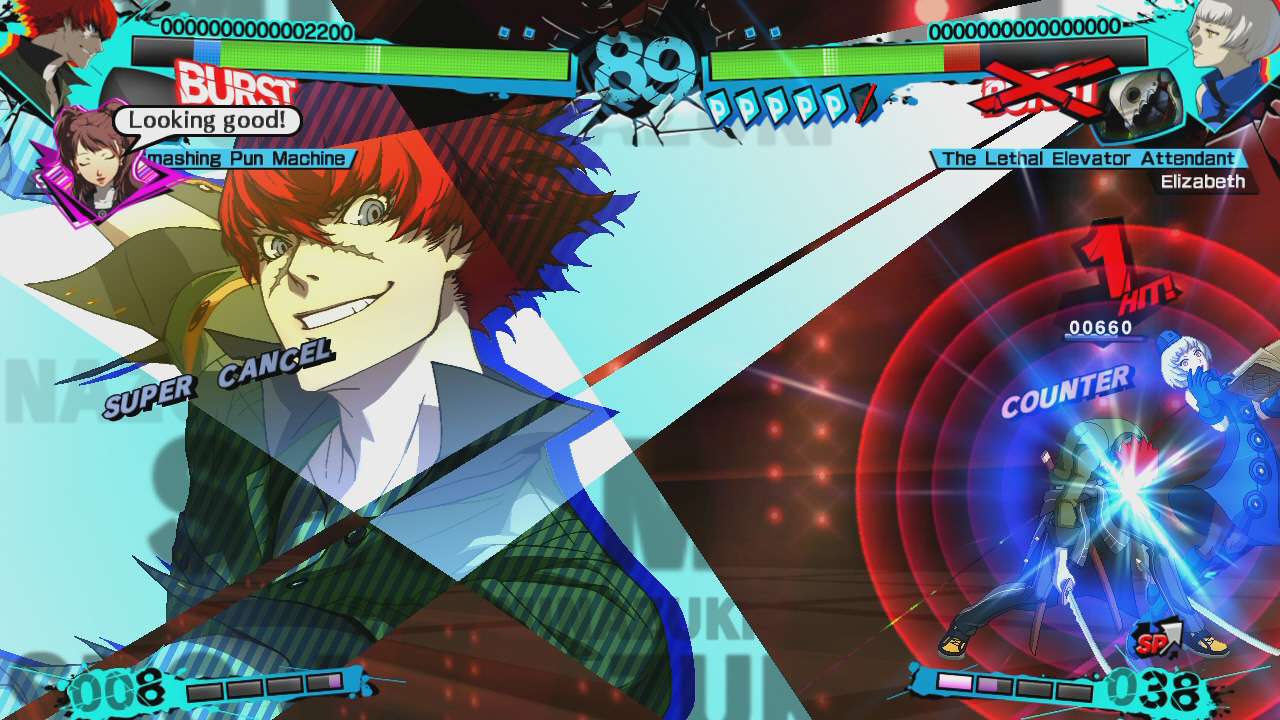Of FES, Golden, and Ultimax.
Persona 4 Arena Ultimax may sound like a remake for the original fighting Persona spin-off released in North America on August 2012, but it's more of a direct sequel that expands the underlying story, the number of available modes, and the size of the character roster. The Super and Ultra versions of Street Fighter IV have re-cemented the marketability of fighting game expansion sequels in the last few years, to the chagrin of Capcom fans who are already tired of paying for minor content upgrades. Perhaps understanding this attitude, Atlus and Arc System Works have ensured that Persona 4 Arena Ultimax deserves its place as a full-on sequel.
The fighting system pretty much remains unchanged in Ultimax, so experts of the first title will feel right at home. Beginners can soak in the details of the system through the in-depth tutorial, learning about throws, air dashes, Persona usage, and the basic auto combo. More experienced fighters will understand guard cancelling, frame traps, hitboxes, the nuances of combo breaking, and the execution behind insane combo strings.
The only significant changes are the introduction of the belligerant dual-sword newcomer Sho Minazuki, several characters from Persona 3—the archer Yukari, the spear-wielding Ken & swift shiba inu Koromaru as a team, and the baseball star wannabe Stupei Junpei—and various shadow variants who you can select at the character selection screen. Shadow forms deal less damage, can't use Bursts, and can't Awaken, but they have higher HP and SP generation, can carry SP from prior rounds, can use Awakened SP Skills anytime, and can enter Shadow Frenzy mode where SP skill cost is reduced. The boosted defensive and magical stats may be worth sacrificing damage and combo interruption if it suits your playstyle.
Continuing only a few days after the ending of Persona 4 Arena, in which the motley crews from Persona 3 and Persona 4 freed the Anti-Shadow Suppression Weapon Labrys from TV World, Ultimax flips the setup of the story on its head. Where P3's characters were confused by P4's TV World, P4's cast in Inaba has now been blindsided by P3's Dark Hour and their school's transformation into another Tartarus, a malefic, multi-floored tower molded for the purpose of calling down the apocalypse.
If you haven't played any of the modern Persona titles, you're likely be bewildered by those two previous sentences, and Ultimax only covers the events of Persona 4 Arena with several brief cut-scenes. But please know that as ridiculous as this all sounds, it all makes sense from the events in the last three Persona games. The characters must still fight one-on-one against each other in the P-1 Climax fighting tournament as hosted by General Teddie, except this time the opponents are shadow forms of other characters and they're curiously not even trying to hide the fact that they're dopplegangers.
Ultimax answers several looming questions from its predecessor, chiefly the identity of the culprit who threw Labrys into the TV World in the first place and how the entire situation seemed to coincide with Yu Narakami's return to Inaba far too coincidentally. Someone is clearly toying with the cast, a point that becomes immediately apparent when the Inaba group sees what's on the Midnight Channel: an image of several key Shadow Operatives including Mitsuru, Fuuka, and Akihiko tied unconscious and crucified on slate-grey T-shaped crosses. This prompts the remaining Persona 3 characters to be called into action and gives the Persona 4 crew (apart from the ever-sharp detective Naoto) no explanation of the Dark Hour and Tartarus until they arrive.
Typically in a review, especially for a fighting game, I wouldn't spend more than several paragraphs detailing the story since the genre isn't known for caring about it, but Ultimax treats its story as if it's an RPG. Belying the card layout of the plot, it follows in fairly linear fashion and delves into each character's point of view for at least twenty minutes apiece, extending to over 8-10 hours of dialogue, voice-acted cut-scenes, and not much actual fighting in between. As a pair, "Episode P4" and the unlockable "Episode P3" essentially tell the same story but with a slightly different arrangement, particularly when it comes to the ending. However, due to the inclusion of every character's point of view, much of the same information is told over and over again at a belaboring pace.
Rounding out the standard spread of Arcade, Versus, Score Attack, and multiplayer offerings is an RPG-oriented Golden Arena mode which Blazblue fans will recognize as an Abyss Mode variant. The challenge is to defeat a sequence of enemies in survival-mode fashion, all while gaining experience points and battle skills from boss characters, similar to how Persona RPGs work with character progression. As your character builds stats in strength, magic, endurance, and agility, and acquires an arsenal of buff, debuff, and healing abilities, you'll progress deeper and deeper down the four courses that range from Normal to Ultimate difficulty, with progressively higher total floors and more higher-level enemies but also with the chance of earning better abilities.
Though Golden Arena characters are restricted to the mode and sadly can't be used even in local multiplayer exhibition matches, Golden Arena is by far the most engaging and challenging mode, which both newbies and veterans will enjoy. My main, Akihiko, has reached the final 200th floor on the Risky course after pouring in about 15 hours' worth of work (probably more, as I've lost count), but I just can't seem to break the boss version of Elizabeth who has sacrilegious stats, instant kills, and abilities (EDIT: I finally beat her!). Disregarding that, though, my main gripes are that losing a match spits you back to the main menu for unnecessary loading screens (a problem throughout the game, actually) and that several skills are obscurely written, like "Oracle" which has the following description: "When HP drops below a set level, various effects occur." Could this be more vague?
More controversial than that is the inclusion of Auto Mode, where the computer can take control over your character in both Story and Golden Arena. So as if the number of battles in Story Mode wasn't already lacking, you can simply breeze through it all on Safety difficulty and Auto Mode without ever throwing a single punch. In Golden Arena, Auto Mode will allow you to effectively grind through lower-level courses for easy experience points. Some matches will ultimately force you to fight manually or at least have your trigger finger on a healing ability. But of course actually playing the game is worth your while too.
Persona 4 Arena Ultimax could have easily been a cash-in, a weak standalone expansion that merely included a few extra characters and call it a day. But both the extensive episodes in story mode and the lengthy Golden Arena mode bolster the already strong multiplayer modes, all of which should satisfy casual fans of the Persona series and hardcore players who wish to perfect their battle skills. Now that the character roster includes essentially all the playable characters from Persona 3 and 4, with more characters like Adachi, Marie, and Margaret to come soon, Ultimax is the true definitive version of Persona 4 Arena.
-
Two extensive story episodes
-
A lot of repeated information and story can be overly long
-
Solid fighting system, balanced fighters for the most part
-
Golden Arena mode
-
Several new characters plus shadow variants
-
Auto Mode makes things way easy but you can grind out Golden Arena mode
-
Could of cut out some loading screens
-
Some DLC characters reportedly on-disc
Persona 4 Arena Ultimax
-
Persona 4 Arena Ultimax #1

-
Persona 4 Arena Ultimax #2

-
Persona 4 Arena Ultimax #3

-
Persona 4 Arena Ultimax #4

-
Persona 4 Arena Ultimax #5

-
Persona 4 Arena Ultimax #6

-
Persona 4 Arena Ultimax #7

-
Persona 4 Arena Ultimax #8

-
Persona 4 Arena Ultimax #9

-
Persona 4 Arena Ultimax #10

-
Persona 4 Arena Ultimax #11

-
Persona 4 Arena Ultimax #12

-
Persona 4 Arena Ultimax #13

-
Persona 4 Arena Ultimax #14

-
Persona 4 Arena Ultimax #15

-
Persona 4 Arena Ultimax #16

-
Persona 4 Arena Ultimax #17

-
Persona 4 Arena Ultimax #18

-
Persona 4 Arena Ultimax #19

-
Persona 4 Arena Ultimax #20












